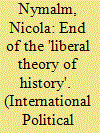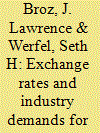| Srl | Item |
| 1 |
ID:
127055


|
|
|
|
|
| Publication |
2013.
|
| Summary/Abstract |
Over the last 10 years, economic issues related to currency policy have become the major ongoing dispute between China and the United States. Specifically, the US Congress has demanded a tougher policy to avert the negative consequences of "unfair" Chinese policies-in the form of a "manipulated currency"-for the US economy. Building on an analytical framework of discourse theory (DT)-and proposing a method for applying DT in empirical research-an investigation into congressional debates on the Chinese currency shows that the question is not a purely economic one, but rather that it reflects a dislocation of US identity as the vanguard of liberal-democratic capitalism. This dislocation involves changes to how "liberal" identity in the US Congress is articulated in relation to the role attributed to "illiberal" China, which in turn affects the formulation of US China policy in Congress.
|
|
|
|
|
|
|
|
|
|
|
|
|
|
|
|
| 2 |
ID:
131503


|
|
|
|
|
| Publication |
2014.
|
| Summary/Abstract |
The recent confrontation between China and the United States over currency policy illustrates a broader phenomenon: exchange-rate misalignments tend to spill over into trade policy. Although previous studies have shown that aggregate protectionist activity is positively related to the level of the real effective exchange rate, we explore this relationship at the industry level. Several industry-specific characteristics determine the protectionist response to exchange rate changes, including the degree of exchange-rate pass-through, the level of import penetration, and the share of imported intermediate inputs in total industry inputs. We find that the marginal effect of currency appreciation on the number of industry-level antidumping petitions is positive and significant only for industries with high pass-through. Therefore, exchange rates appear to induce demands for trade barriers only in industries where competitiveness is directly harmed by currency appreciation.
|
|
|
|
|
|
|
|
|
|
|
|
|
|
|
|
| 3 |
ID:
171826


|
|
|
|
|
| Summary/Abstract |
This paper revisits the validity of the weak currency policy in Vietnam. It estimates the income and exchange rate elasticities of Vietnam’s bilateral export and import demand with its twenty-three trading partners between 1994 and 2016. The Fully Modified OLS (FMOLS) estimates suggest that the income elasticities of both export and import demand are consistently significant and more elastic with expected positive signs. Meanwhile, the exchange rate elasticities are inconsistent in terms of their size, sign and statistical significance. In general, bilateral import demand, compared to bilateral export demand, shows considerably inelastic exchange rate elasticity with signs that are opposite to expectation. Only three countries satisfy the Marshall-Lerner condition. Also, the influence of income over trade balance outweighs that of exchange rate. The weak currency policy that was once claimed to be effective is now ineffective in Vietnam as the country’s external sector is dominated by foreign-invested enterprises.
|
|
|
|
|
|
|
|
|
|
|
|
|
|
|
|